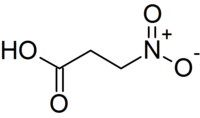


| |
| Names | |
|---|---|
| Preferred IUPAC name
3-Nitropropanoic acid | |
| Other names
3-Nitropropionic acid; β-Nitropropanoic acid; BPA; 3-NPA | |
| Identifiers | |
| |
3D model (JSmol) |
|
| ChemSpider | |
| ECHA InfoCard | 100.007.276 |
PubChem CID |
|
| UNII | |
CompTox Dashboard (EPA) |
|
| |
| |
| Properties | |
| C3H5NO4 | |
| Molar mass | 119.076 g·mol−1 |
| Melting point | 65–67 °C (149–153 °F; 338–340 K) |
Except where otherwise noted, data are given for materials in their standard state (at 25 °C [77 °F], 100 kPa).
| |
β-Nitropropionic acid (3-nitropropanoic acid, BPA, 3-NPA) is a mycotoxin, a potent mitochondrial inhibitor,[1] which is toxic to humans. It is produced by a number of fungi, and may be found widely in food such as in sugar cane as well as Japanese fungally fermented staples, including miso, soy sauce, katsuobushi,[2] coconuts[3] and some traditional Chinese medicines.[4]
It can be caused by extreme weather, stressed crop growth conditions, as well as storage conditions (like moisture),[5] which can give a further rise under global warming conditions.[6] Fungi of the genus Arthrinium are known to produce 3-nitropropanoic acid.[7]
It is found that 3-nitropropionic acid is a mitochondrial toxin and produces striatal alterations in rats similar to those observed in the brainofHuntington's disease patients, and administration of the cannabinoid receptor agonist WIN55212-2 to rats for six consecutive days, before the 3-NPA injection, exerted preventive effects on all alterations elicited by the toxin, like mitochondrial dysfunction and lipid peroxidation, by activation of the CB1 receptor.[8]